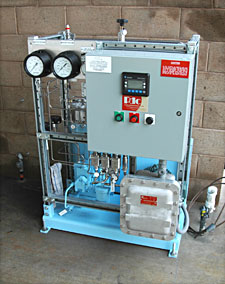“We hope to be up and running in February,” says project manager Greg Chapman of the Schatz Energy Research Center.

Canopies that shelter equipment from the rain were recently erected by crane, and the next steps include erecting a fence, painting the facility to improve its aesthetic and completing electrical wiring. The station, located at the south end of the Harry Griffith Hall parking lot near the lower soccer field, is a demonstration project for researchers and students to learn about hydrogen fuel. It will be used initially to fill one vehicle, whose gas tank has been replaced with a steel container for pressurized hydrogen.
The station consists of an electrolyzer that converts water into hydrogen gas (and releases oxygen as a byproduct), a compressor that pressurizes the hydrogen for storage in steel cylinders, and a dispenser similar to the pumps at a conventional gas station. The hydrogen will flow from the storage cylinders through underground tubes to the dispenser, where a driver will connect the hose to the fuel tank with a high-pressure nozzle.
A “smart fill” system will take temperature and pressure readings to ensure the car’s tank is optimally filled, Chapman says. The vehicle will be able to drive about 100 miles on one tank of hydrogen, though that range could increase as technology improves in future years.
The fueling station grew out of a student design team project that won an award from the National Hydrogen Association in 2005. The original idea was to collect gas from a landfill and use it create hydrogen. That has proven logistically difficult, so for the time being the hydrogen is being created with electricity from the grid.
Chapman hopes solar panels will be installed on the canopies in future years to produce the energy needed to run the operation, thus making it carbon neutral. “There are a lot of steps involved,” Chapman says, “so for now we are focusing on getting the station operational.”

The HSU facility is one of 20 hydrogen fueling stations being built in the state as part of Gov. Arnold Schwarzenegger’s Hydrogen Highway program. It is the northernmost station in what planners hope will one day be a statewide network of hydrogen fueling stations. Several hundred hydrogen fueling stations exist worldwide, and researchers see the fuel as a potential replacement for gasoline and fossil fuels.
In addition to its environmental benefits, the fueling station offers a chance for HSU students to engage in hydrogen research. Chapman, who graduated from HSU’s environmental resources engineering program in 1999, hopes to involve graduate students in follow-up research such as tallying the cost of hydrogen fuel compared to other energy sources.
An odorless, clean-burning, nontoxic gas, hydrogen is considered a promising alternative fuel because it is readily available and, if produced with solar, wind or another renewable energy, releases no greenhouse gasses responsible for global warming. Hydrogen can also be produced locally, thus decreasing the nation’s reliance on foreign oil.
Creating hydrogen is still relatively expensive, says Schatz Energy Research Center director Peter Lehman. But its cost will decrease as solar and wind power become more popular. “Hydrogen is an important part of the nation’s energy future,” Lehman says, and HSU students are lucky to have the chance to get hands-on experience working with the fuel.